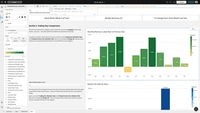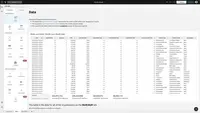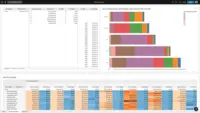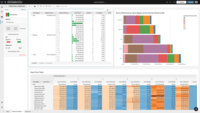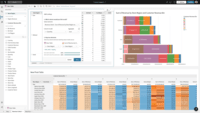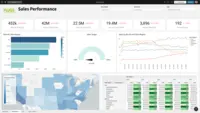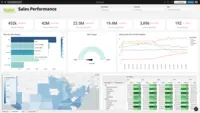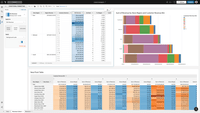Overview
What is Sigma?
Sigma Computing headquartered in San Francisco provides a suite of data services such as code free data modeling, data search and explorating, and related BI and data visualization services.
Great tool with some weird kinks
Sigma Recommended.
Sigma Rolling Out.
My Sigma Review
Sigma Review
Nearly perfect, missing some nice to have features
I tell everyone about Sigma!
Great BI tool loved by many business stakeholders
A data analysis tool that is easy implement and easy to learn.
Love Sigma
Getting data into your users' hands quickly and easily
Excellent Tool for Business Analysis
Actionable and fun data analytics
Sales Ops Usage
How Sigma Differs From Its Competitors
Self-Service Analytics
Ad Hoc Analytics
Self-Service Analytics
Ad Hoc Analytics
Self-Service Analytics
Ad Hoc Analytics
for some more technical user, we can …
Self-Service Analytics
Ad Hoc Analytics
Self-Service Analytics
This helps us inform …
Ad Hoc Analytics
Self-Service Analytics
Sigma allows IT to provide data from outside sources in a way that was not possible before.
Self-Service Analytics
Ad Hoc Analytics
Self-Service Analytics
Ad Hoc Analytics
Self-Service Analytics
Ad Hoc Analytics
Self-Service Analytics
Ad Hoc Analytics
Self-Service Analytics
Ad Hoc Analytics
Sigma Computing SQL Knowledge
Sigma Access Speed
Sigma Computing Pricing Model
Sigma Computing SQL Knowledge
Sigma Access Speed
Sigma Computing Pricing Model
Sigma Computing SQL Knowledge
Sigma Collaboration
Sigma Access Speed
Sigma Computing Pricing Model
Sigma Computing SQL Knowledge
Sigma Collaboration
Sigma Access Speed
Sigma Computing Pricing Model
Sigma Computing SQL Knowledge
Sigma Collaboration
Sigma Access Speed
Sigma Computing Pricing Model
Sigma Computing SQL Knowledge
Sigma Collaboration
Sigma Access Speed
Awards
Products that are considered exceptional by their customers based on a variety of criteria win TrustRadius awards. Learn more about the types of TrustRadius awards to make the best purchase decision. More about TrustRadius Awards
Popular Features
- Drill-down analysis (150)8.585%
- Report sharing and collaboration (156)8.282%
- Customizable dashboards (155)7.777%
- Formatting capabilities (157)7.373%
Reviewer Pros & Cons
Pricing
What is Sigma?
Sigma Computing headquartered in San Francisco provides a suite of data services such as code free data modeling, data search and explorating, and related BI and data visualization services.
Entry-level set up fee?
- Setup fee optional
Offerings
- Free Trial
- Free/Freemium Version
- Premium Consulting/Integration Services
Would you like us to let the vendor know that you want pricing?
153 people also want pricing
Alternatives Pricing
What is Microsoft Power BI?
Microsoft Power BI is a visualization and data discovery tool from Microsoft. It allows users to convert data into visuals and graphics, visually explore and analyze data, collaborate on interactive dashboards and reports, and scale across their organization with built-in governance and security.
What is Tableau Desktop?
Tableau Desktop is a data visualization product from Tableau. It connects to a variety of data sources for combining disparate data sources without coding. It provides tools for discovering patterns and insights, data calculations, forecasts, and statistical summaries and visual storytelling.
Features
BI Standard Reporting
Standard reporting means pre-built or canned reports available to users without having to create them.
- 7Pixel Perfect reports(100) Ratings
Pixel Perfect reports are highly-formatted reports with graphics and ability to preview the report before printing.
- 7.7Customizable dashboards(155) Ratings
Customizable dashboards are dashboards providing the builder some degree of control over the look and feel and display options.
- 7.1Report Formatting Templates(127) Ratings
Ad-hoc Reporting
Ad-Hoc Reports are reports built by the user to meet highly specific requirements.
- 8.5Drill-down analysis(150) Ratings
Drill down analysis is the ability to get to a further level of detail by going deeper into the hierarchy.
- 7.3Formatting capabilities(157) Ratings
Ability to format output e.g. conditional formatting, lines, headers, footers.
- 7.3Integration with R or other statistical packages(5) Ratings
Integration with the open-source R predictive modeling environment.
- 8.2Report sharing and collaboration(156) Ratings
Report sharing and collaboration is the ability to easily share reports with others.
Report Output and Scheduling
Ability to schedule and manager report output.
- 9.3Publish to Web(99) Ratings
- 8.1Publish to PDF(124) Ratings
- 9.4Report Versioning(114) Ratings
Report versioning is the assignment of version numbers to each version of a report to help in tracking.
- 9.2Report Delivery Scheduling(127) Ratings
Report Delivery Schedule is the ability to have reports delivered to a destination at a specific data and time.
- 8.3Delivery to Remote Servers(64) Ratings
Ability to deliver reports to remote servers
Data Discovery and Visualization
Data Discovery and Visualization is the analysis of multiple data sources in a search for patterns and outliers and the ability to represent the data visually.
- 7.3Pre-built visualization formats (heatmaps, scatter plots etc.)(141) Ratings
Pre-built visualization formats are canned visualization types that can be selected to visualize different kinds of data.
- 5.6Location Analytics / Geographic Visualization(26) Ratings
Location analytics is the visualization of geographical or spatial data.
- 6.2Predictive Analytics(18) Ratings
Predictive Analytics is the ability to build forecasting models based on existing data sets.
Product Details
- About
- Integrations
- Competitors
- Tech Details
- Downloadables
- FAQs
What is Sigma?
Sigma is a business intelligence (BI) and analytics platform purpose-built for the cloud. With Sigma, anyone can use the spreadsheet functions and formulas they already know to explore live data at cloud scale, down to the lowest grain of detail. Its familiar spreadsheet-like interface delivers SQL into the hands of any user while keeping data fresh and secure within cloud data warehouses.
Data-first companies can use Sigma to empower their employees, customers, and partners to break free from the confines of the dashboard and explore data for themselves to make better, faster decisions. The software was built to capitalize on the performance power of cloud data warehouses to combine data sources and analyze billions of rows of data instantly – no coding required.
Sigma Features
BI Standard Reporting Features
- Supported: Pixel Perfect reports
- Supported: Customizable dashboards
- Supported: Report Formatting Templates
Ad-hoc Reporting Features
- Supported: Drill-down analysis
- Supported: Formatting capabilities
- Supported: Predictive modeling
- Supported: Report sharing and collaboration
Report Output and Scheduling Features
- Supported: Publish to Web
- Supported: Publish to PDF
- Supported: Output Raw Supporting Data
- Supported: Report Versioning
- Supported: Report Delivery Scheduling
- Supported: Delivery to Remote Servers
Data Discovery and Visualization Features
- Supported: Pre-built visualization formats (heatmaps, scatter plots etc.)
Sigma Screenshots
Sigma Videos
Sigma Integrations
Sigma Competitors
Sigma Technical Details
| Deployment Types | Software as a Service (SaaS), Cloud, or Web-Based |
|---|---|
| Operating Systems | Unspecified |
| Mobile Application | Mobile Web |
| Supported Countries | United States, Canada |
Sigma Downloadables
Frequently Asked Questions
Comparisons
Compare with
Reviews and Ratings
(287)Attribute Ratings
Reviews
(1-17 of 17)A data analysis tool that is easy implement and easy to learn.
- Allows end users to easily dive into the data without having direct access to the table in our database management software.
- Can easily turnaround dashboards that are detailed and visually pleasing.
- Sigma is intuitive and as new features are rolled out it is easy to adopt and incorporate them into new and existing dashboards.
- Improved period over period functionality within the KPI Visual that would allow me to compare one year to another without including all years in the visual. I.E. the primary value is 2022 and the comparison line is 2021.
- Greater ability to customize aspects of different visuals such as color, font and font size.
- The ability for certain elements or blocks of elements to move as one scrolls down the page. I.E. I would enjoy the ability to create a set of filter elements along one side of the dashboard that scrolls with the user as the user scrolls down the page to view various visuals.
Getting data into your users' hands quickly and easily
- Easily connects to Snowflake.
- dbt Integration to show column level definitions and dataset metadata (freshness, size, rows, etc.)
- Very quickly create workbooks and content.
- Unlimited viewer model, so everyone in the company can have read-only access.
- Viewer level license is quite limited. These users can't download data or even add filters on datasets. Something to keep in mind.
- Directly querying the underlying data warehouse will lead to increased usage. Not a big deal on something like Redshift, but your Snowflake consumption will increase, potentially by a lot.
Sigma Computing is an amazing BI solution if you want to build self-serve data product
- Export function in Sigma Computing is amazing.
- Speed compare to Tableau
- easy to get started for non technical users
- release updates all the time
- Love the live chat function
- some new features are released with a log of bugs
- aesthetically not as good as some of the competitors
- not addressing open requests fast enough. or at least provide some updates
Great, but Limited for Now.
- Disseminate workbooks and information through user profiles and features with a relatively low learning curve.
- Customization tools for colors/branding.
- Limitation in visualizations that lead to long workarounds to get features we want, or to be able to display data in the way we like it.
- Limit choices in customization when it comes to fonts, text size, and element sizing.
- Difficulty in handling complicated dashboard designs that require multi-element/section movement and a higher number of elements.
Sigma: As easy to use as Excel, as powerful as Tableau.
On a daily basis, use it to determine a broad range of things:
Product performance:
- Observing past trends and predict future trends in product usage
- Identify broad trends that could lead to product improvements
- Help clients get the maximum potential from our product by observing how its being used
- Identify areas where costs to us, or the client, may be unnecessarily high and address
- Proactively identify issues and reach out to clients for troubleshooting and resolution
- Reach out to clients who are not using the product to its maximum potential and assist in helping their projects succeed
- Maximize delivery to our clients by identifying the causes of shortfalls
- Customer Support: They've always been very quick to respond, willing to help work to come up with solutions for anything I'm stuck on.
- Very quick and easy to create reports with, once a solid dataset has been built.
- Low Code/No Code UX is intuitive to any excel users.
- Many options for joining different data sources.
- Adding new features regularly
- Formatting: On workbooks and dashboards, it can sometimes be difficult to make the page elements align correctly.
- When creating and setting up datasets, having a temporarily row-limiting option when editing would help a lot, particularly on anything with a large number of rows.
- Scheduling reports to be sent out can be tricky if the request is something like "Last Monday of each month".
- Being able to export an xls with conditional formatting would be helpful in some cases.
The scenarios where Sigma is less appropriate are when a task needs to be confirmed. If we reach out to a client regarding an issue, we can't indicate it was done in Sigma. I don't consider this a Sigma issue, as it's not meant to be a workflow tool.
Sigma is Success for Any Size Data Program
- Guides business type users through a JOIN
- Allows for some types of data engineering in the dataset creation.
- Provides instantaneous user help and support
- The Join functionality in worksheets is incredibly useful but that same view is not available in worksheets. Is there a way to combine that?
- Make the datasets about data engineering models. Leave worksheets to using those models and other data.
Sigma is also great for a big company where there is more demand for data discovery than the IT team has capacity.
Good enough, worth spending time with.
- Pivot tables, allowing user control for navigating summary/detail views of data
- Visualization
- Speed to delivering dashboard, we have generally been quick to at least prototype dashboards
- Smart comprehension and options for date, numeric and text fields.
- The interface is busy with multiple modes to accomplish similar tasks, so not always intuitive to do some tasks
- While a more specific case of my first point, the relationship between different screen elements is particularly not obvious
- On chart annotation, allowing comments that overlay chart data
Sigma seemed comparable to other tools in the space and what won us over was how quickly we could spin up a dashboard.
Sigma Computing : for the modern Data Driven world
- Ease of use when creating and implementing new worksheets
- Quick iterative development of datasets
- Adoption metrics of new datasets
- Access to query our own metrics
- Having workbook visualizations to pull from 1 source yet provide different information
- Usage metrics of workbooks and any tabs contained within them
Sigma Good and Bad
We try to replace all our existing tabular reporting with Sigma's new good-looking workbooks. For this we have set up a new warehouse, which is directly used by Sigma for presenting production data.
- Support
- Ease of use
- Embedding
- Visualizations
- Tabular reports
- Customization
Main disadvantage is that as it is a new product, and has no long history, there are plenty of features that are missing(Linking objects, customization of tabular reports).
In my experience, business user are constantly asking things that can not be done by Sigma.
Also I am facing bugs quite often.
However, Sigma is improving quite fast and they are working on new features. Support is very quick and quite helpful, they have live chat which really is a good way to have answers on your questions. Also I think they have reasonable pricing, especially if you want to use it for application embedding. You should really check your requirements, before choosing them, but I have a feeling that Sigma will be better and better time to time.
Wouldn't recommend
- Charts look pretty good, not as good some other bi tools
- Its somewhat easy to work with very simple datasets
- It does a good job of making it take much longer to develop visualizations than any other bi tool I've used, and I've used a lot
- No support for any kind of scripting, everything must be done via gui which makes it harder to re-use previous work
- Copying from one dashboard to another is not supported. Which is weird
- Logic for a calculation is difficult to see, it gets lost in "children" datasets
- Lots of minor ui issues, hover over in charts often stick on the screen obscuring other things, long column names are cutoff
- Filters can be applied upstream of a table making it difficult to tell which filters are impacting a given output
- Would be helpful to pass input parameters to SQL queries.
- Version control approach is baffling. If you click edit you might go to a previous unpublished version from months prior, ui is somewhat confusing to get to the current version. Also very problematic if working on the same workbook as a coworker
- Its much harder than it should be to view sql for a dataset, and most users roles do not have access to view it
- The similarity to spreadsheet tools (G Sheets, Excel) enables end-users to quickly get up to speed without much training.
- The end user interface is clean and clear.
- Sigma support is great - they're friendly, always available for a quick chat or a screen share, and knowledgeable about the product and able to provide solutions and workarounds to any issues or reporting needs.
- The flexibility of using SQL, analytics-created datasets, CSVs, or any combination of those is ideal for a smaller organization like us - it enables us to be more responsive to evolving user and business needs, especially as we grow.
- Because it's spreadsheet-based, the UI can be tricky or unintuitive to use at times (especially for those used to other BI tools).
- Options and functionality for things like charts or dashboard filters can be clunky or non-existent but Sigma is great about taking feature requests and is continually rolling out new features and improvements.
An easy way to expose data
- Easy way to get aggregated data without writing SQL.
- Easy way to visualize the data.
- Easy way to manipulate the data by built-in functions.
- It's not clear what's the implementation if we are doing more complicated join and filter.
- It can only support to export the data up to 10,000 rows.
- Little online resources for use cases or questions.
My Sigma Review.
- Queries Snowflake.
- Automated reports.
- Working in the individual tables.
- Adjusting the screen size for some menus on the left.
- The layout of Sigma in general needs improvement.
- It needs more report automation functionality.
Democratizing Data: From a Non-Data/Engineering Perspective
- Clean UI makes the powerful system approachable and inviting to begin sandbox testing.
- Modular approach. You can pivot and pull and plug away so much. The permutations are endless with lots of visualizations and integrations to keep the data and insights flowing.
- Great for multi-user and getting people set-up across the org.
- Though the tutorial click through at initial sign-up is done great, I wish there were some additional ways to learn about the product at the early stages. It's almost as if they begin with lots of help and support and then expect you to be great on your own and help becomes overly technical. Probably not bad for data scientists but definitely affected the want to use the tool daily (it kind of plateaued).
- I'd like to see better sales material/education. My org has lots of people familiar with Mode & Tableau, so we wanted to have clearer comparisons of why it's worth switching over to this new tool. Why is it so much better? That needs to be clearer.
A non-technical, user friendly analytics tool
- Simple spreadsheet-like user interface. If you know Excel or Google Docs, you can use Sigma Computing to do complex analysis.
- Flexible in that power users can narrow down result sets directly if they know how to do SQL, but SQL knowledge is not required to to analyze data.
- Easy to share completed reports and graphical data with teams, without requiring team members to have paid accounts.
- Because Sigma Computing sits directly on top of the analytics data warehouse it queries live data. Not the most efficient when it comes to speed and requires attention from data specialist to make sure the warehouse is optimized to support the queries.
- Access control is loosely governed. Meaning pretty much granular access to specific tables or schemas hard to manage. Sharing a report means granting implicit access to the source data.
- Change management is tricky. Renaming of tables means re-creating reports, rather than just being able to point existing reports at a new table.
- Your user base is relatively low level of technical ability with analytics tools
- You need to generate sharable reports
- You must have access to up to the minute up to date information
- You have the ability to support the back-end data warehouse by scaling a cluster to support heavyweight (auto-generated) SQL queries
- You have a highly technical analytics team as your user base
- You need tightly controlled access to down to the table/row/field/schema levels
- Your users primarily spend their time working in SQL
The big win for me with Sigma Computing, is that it allows me to take a set of queries that I would normally run by hand once a week, or once a month, and lets me view the data almost instantly without having to pull and manipulate it. I set up my queries one time, perform any translation or added layers I need (which Sigma is great at, stuff I can't do in Excel or anywhere else automatically) and then push them to a dashboard that I can load each morning.
- Allows a quick look at important data that moves every day.
- Frees up a lot of my time from manually running, downloading, loading, and translating data.
- Allows me to easily share my findings with a quick link.
- I would love to see some additional visualizations added. I find myself using the same 2 or 3 on all of my dashboards, which is functional, but I would like some choices to make things a little more visually appealing.
- I would like to adjust the timeout options I have when querying the data. It would be nice to force a longer timeout for some of the tables I have that are larger and take a while to get data from.
- Scheduling dashboards to send snapshots to Slack fail more often than they work. It is a feature I do not use much, because I cannot rely on it.
- The ability to set the screen size of the VM that takes the snapshots would be useful. I have a high resolution screen that I set my dashboards up to be visible on, and when I get a report emailed to me, it is always cut off because the resolution on the VM that takes the snapshot is much lower.
One problem area is if you have any super massive DBs. Since Sigma isn't storing data, it has to pull it every time for you. If your DB is huge, or poorly indexed, it can take a long time, or time out.
Why did it take us so long to get Sigma?
- The different options to display data, whether it's a chart, just numbers or a combination of both.
- The ability to expand deep into the numbers with a simple click
- Sometimes it takes a while for data to load depending on size of the database
- Had some issues with errors coming out or database not loading properly


